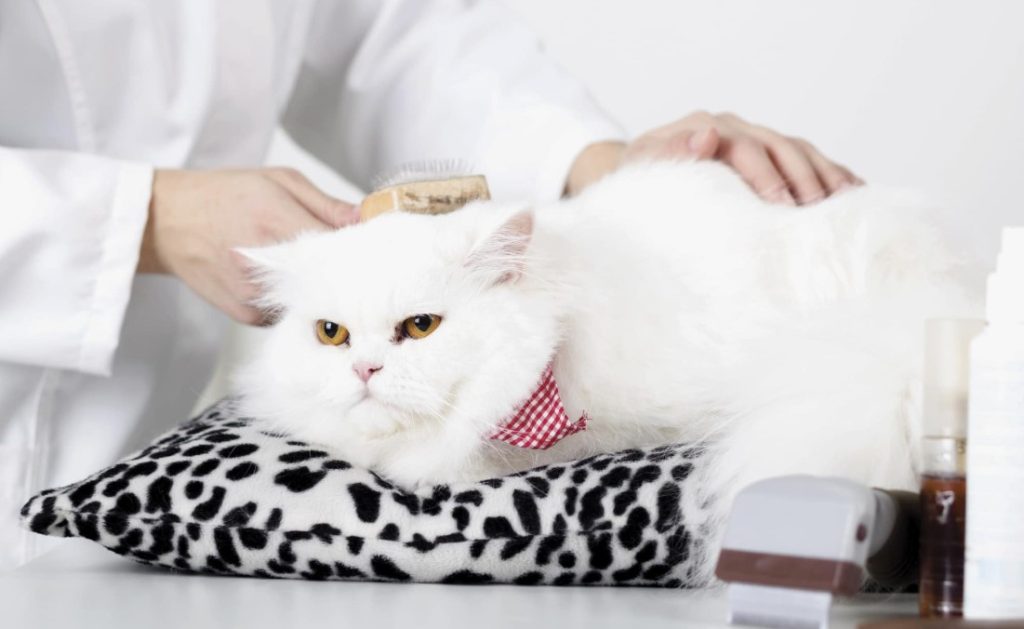Worms in cats are a common yet often unnoticed health issue that can significantly affect a cat’s well-being. Helminthic infestations (parasitic worm infections) not only pose a risk to cats but can also be transmitted to humans, creating a broader concern for both pet owners and their households. Among the various types of parasitic worms that affect felines, tapeworms, or cestodes, are some of the most frequent culprits. These long, flat worms can silently damage a cat’s internal organs, compromising their health and even threatening their lives if left untreated. Regular veterinary care, such as the services provided by The Ark Animal Clinic, can help diagnose and treat such infestations early, ensuring the well-being of your pet.
What Are Tapeworms and How Do They Affect Cats?
Tapeworms in cats are parasitic flatworms that attach themselves to the lining of a cat’s small intestine using hook-like structures in their mouths. They feed off the nutrients absorbed by the cat’s digestive system, which can lead to various health problems over time. The infection can be difficult to detect at first, as symptoms often develop gradually. However, once the tapeworm population inside a cat’s body grows, the signs of infection become more evident, manifesting in both physical and behavioral changes.
The Life Cycle of Tapeworms
The tapeworm’s life cycle involves multiple stages, which complicates the prevention and treatment of this parasite. It begins when a cat ingests an infected flea, louse, or rodent. The tapeworm larvae enter the cat’s digestive system, where they grow and mature. Inside the small intestine, they anchor themselves and begin feeding off the nutrients the cat consumes. The adult worms produce segments filled with eggs, which are then shed in the cat’s feces. These segments, often resembling grains of rice, can be seen in the fur around the cat’s anus or in their litter box. The eggs within the segments can then be ingested by fleas or other intermediate hosts, continuing the cycle.
Common Types of Tapeworms in Cats
Tapeworms come in various species, each with distinct methods of transmission and effects on the cat’s body. Two of the most commonly encountered types of tapeworms in cats are:
1. Cucumber Tapeworm (Dipylidium caninum)
The cucumber tapeworm, also known as Dipylidium caninum, is one of the most widespread tapeworms found in domestic cats. This type of tapeworm causes dipylidiosis, a condition that leads to digestive issues, allergic reactions, vomiting, and lethargy. Cucumber tapeworms get their name because their segments, which contain egg packets, resemble cucumber seeds when expelled from the cat’s body.
🡪Transmission
Cats become infected with cucumber tapeworms by swallowing fleas or lice, which act as intermediate hosts for the larvae. Fleas are commonly ingested during grooming when the cat bites or licks its fur to remove irritants.
🡪Effects on Cats
The tapeworms attach themselves to the intestinal lining, causing malnutrition and irritation. Over time, the infestation can lead to severe weight loss, poor coat condition, and overall ill health.

2. Broad Tapeworm (Diphyllobothrium latum)
The broad tapeworm, also known as Diphyllobothrium latum, is another common type that infects cats. Unlike the cucumber tapeworm, the broad tapeworm is primarily transmitted through the consumption of raw or undercooked fish.
🡪Transmission
Cats typically become infected by eating fish that contain the larvae of this tapeworm. Freshwater fish are more likely to be carriers of these parasites, making it particularly dangerous for cats that have access to rivers or ponds or are fed raw fish.
🡪Effects on Cats
Broad tapeworms can live undetected in a cat’s body for long periods, gradually leading to severe anemia. The tapeworms deprive the cat of essential nutrients, weakening its immune system and making it more susceptible to other diseases.
Recognizing the Symptoms of Tapeworm Infection in Cats
Tapeworm infections can often go unnoticed in cats, especially in the early stages of infestation. However, as the worms multiply and grow, symptoms become more apparent. Pet owners should be vigilant for the following signs of tapeworm infection:
🡪Visible Tapeworm Segments
One of the most obvious signs of a tapeworm infestation is the presence of small, rice-like segments in the cat’s fur around the anus or in the cat’s feces. These segments contain the eggs of the tapeworm and may be seen in the cat’s bedding or litter box.
🡪Poor Coat Condition
Tapeworms can cause a cat’s coat to become dull, thin, or unkempt, as the parasites deplete essential nutrients that contribute to a healthy coat.
🡪Loss of Appetite and Weight Loss
A cat infected with tapeworms may show reduced interest in food or may lose weight despite eating regularly. This is due to the parasites absorbing the nutrients that the cat ingests.
🡪Diarrhea and Vomiting
Digestive issues, including diarrhea and vomiting, are common signs of a tapeworm infection. Vomiting may also expel whole or fragmented tapeworms in some cases.
🡪Coughing
In rare instances, migrating larvae can cause respiratory irritation, leading to coughing.
🡪Blood in Feces
Damage to the intestinal wall caused by the hooks of the tapeworm may result in minor bleeding, visible in the cat’s feces.

🡪Coating on the Tongue and Bad Breath
The stress on the digestive system can lead to oral health issues, manifesting as a white coating on the tongue and persistent bad breath.
🡪Eye Discharge and Pale Mucous Membranes
Severe tapeworm infestations can cause anemia, leading to pale gums and discharge from the eyes.
🡪Excessive Grooming or Scooting
Cats may drag their bottoms on the floor, or excessively lick their anal area due to irritation caused by the presence of tapeworm segments.
Behavioral Changes
Infected cats may display noticeable changes in their behavior, such as:
🡪Lethargy
Cats may become unusually tired and disinterested in playing, sleeping more than usual, or avoiding activities they once enjoyed.
🡪Apathy
A cat infected with tapeworms may appear indifferent or uninterested in its surroundings, not engaging with its owner or other pets as frequently.
Consequences of Tapeworm Infestations in Cats
If a tapeworm infection is left untreated, it can lead to severe and sometimes life-threatening consequences for the cat:
🡪Mechanical Damage
Tapeworms attach to the intestinal wall using suckers and hooks, causing physical injuries such as tears, hemorrhages, and necrosis (tissue death). This mechanical damage weakens the digestive system and can create ulcers or open wounds.
🡪Intestinal Blockage
A heavy infestation of tapeworms can cause a complete intestinal blockage, preventing the cat from passing food or waste. This is a medical emergency that requires immediate veterinary intervention.
🡪Toxic Reactions
As tapeworms grow and multiply, they excrete waste products that can poison the cat’s body, leading to symptoms of general intoxication, such as weakness, dizziness, and severe illness.
🡪Immune Suppression
The continuous damage caused by the worms weakens the cat’s immune system, making it more vulnerable to bacterial and viral infections.
🡪Dysbacteriosis
The presence of tapeworms disturbs the natural balance of gut bacteria, favoring harmful microorganisms and leading to chronic digestive problems like diarrhea, gas, and bloating.
🡪Cardiovascular Issues
In severe cases, the worms can press against blood vessels, disrupting blood flow and increasing the risk of cardiovascular complications.
Effective Treatment for Tapeworms in Cats
The good news is that tapeworm infections are treatable, and with the proper veterinary care, most cats can recover fully. The primary treatment involves the administration of anthelmintic medications containing praziquantel, a drug specifically designed to target and eliminate tapeworms.
🡪Forms of Medication
Anthelmintic medications come in several forms, including tablets, oral suspensions, and topical drops (often applied to the withers). The method of administration will depend on the cat’s health, size, and behavior.
🡪Dosage
The dosage is carefully calculated based on the cat’s weight, ensuring the treatment is both effective and safe. It is essential to follow the vet’s instructions closely, as under-dosing may not fully eliminate the parasites, while over-dosing can lead to side effects.
Post-Treatment Care and Preventative Measures
After treatment, several preventative steps should be taken to avoid re-infection and ensure the cat’s continued good health:
🡪Flea Control
Since fleas are a common intermediate host for tapeworms, regular flea prevention is critical. Flea collars, topical treatments, and oral medications can help keep your cat free from these pesky parasites.
🡪Limit Hunting
Preventing your cat from hunting small rodents and birds will reduce the risk of exposure to tapeworm larvae, as many wildlife species carry the parasites.
🡪Proper Hygiene
Clean and disinfect the cat’s litter box, bedding, and toys regularly to reduce the chances of reinfection. Keep outdoor shoes away from the cat, as they may carry parasite eggs.
🡪No Raw Fish
Avoid feeding your cat raw or undercooked fish, especially freshwater varieties, as they can harbor tapeworm larvae.
Regular Deworming
For long-term protection, veterinarians recommend routine deworming every three months. In cases where a cat is at higher risk of contracting parasites (e.g., outdoor cats), more frequent deworming treatments may be necessary.
Prevention of Tapeworm Infections in Cats
To minimize the risk of future infestations, take the following precautions:
🡪Avoid raw or undercooked fish in your cat’s diet, especially from freshwater sources.
🡪Clean the litter box frequently, ensuring that it remains free of fecal matter, where tapeworm eggs may be found.
🡪Treat for fleas regularly to prevent the ingestion of flea larvae, which carry tapeworm eggs.
🡪Administer preventative deworming treatments every three months, or more frequently if recommended by your veterinarian.
The Ark Animal Clinic: Trusted Deworming Services
For professional care and high-quality deworming treatments, consider visiting The Ark Animal Clinic. Established in 2013, The Ark has grown into a trusted partner for pet owners seeking reliable and compassionate veterinary care. Located in Cairo, with branches in Dubai and Dahab, The Ark offers comprehensive deworming services tailored to your cat’s needs.
At The Ark, we use safe and effective deworming products, including praziquantel, to treat and prevent tapeworm infestations. Our experienced team ensures your cat receives the care they need, whether they are suffering from tapeworms or other common parasites. Our services are designed to promote long-term health and prevent future infections, giving you peace of mind that your feline companion is in good hands.

I serve as a financial expert on the Today Show and Good Morning, America. I like to give reasonable advice on budgeting to people with any income level.
